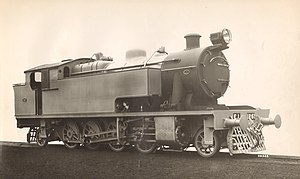Indian locomotive class HT
| Indian locomotive class HT | |||||||||||||||||||||||||||||||||||
|---|---|---|---|---|---|---|---|---|---|---|---|---|---|---|---|---|---|---|---|---|---|---|---|---|---|---|---|---|---|---|---|---|---|---|---|
 Works photo of EIR no.1251 | |||||||||||||||||||||||||||||||||||
| |||||||||||||||||||||||||||||||||||
| |||||||||||||||||||||||||||||||||||
| |||||||||||||||||||||||||||||||||||
| Reference: [2], unless where noted | |||||||||||||||||||||||||||||||||||
The Class HT (Heavy Tank) was a broad-gauge tank locomotive, designed for use in the British Raj. It was one of seven standard broad-gauge locomotive classes designed by the British Engineering Standards Committee, later renamed the British Engineering Standards Association (BESA).
History
[edit]At the turn of the 20th century, the railways in British India utilised numerous classes of locomotives of differing designs, and there was an urgent need of standardisation. A subcommittee of the British Engineering Standards Committee (BESA) therefore designed several standardised classes of locomotives between 1903 and 1910 in three successive editions, with the Class HT being a later addition to the third report of the BESA Standard in 1910.[3][4] The design was similar to the locomotives delivered in 1921 to the Bengal Nagpur Railway (BNR), which were made using parts shared with the other BESA locomotives.[5] The Class HT had the same cylinder dimensions as the HGS/HGC class freight locomotives, whereas the boiler was shared with the Class PT 2-6-4T locomotives.[6]

During the 1920s, Beyer, Peacock & Co. delivered the HT class locomotives for the North Western Railway and the East Indian Railway. Some were in active service as of 1978, allocated to Dhanbad and Pathardth sheds of Eastern Railways.[1][7]
See also
[edit]- Indian locomotive class SP
- Indian locomotive class SG
- Indian locomotive class AP
- Indian locomotive class HP
- Indian locomotive class HG
- Indian locomotive class PT
References
[edit]- ^ a b c d Hughes 1979, p. 54.
- ^ Hughes 1979, p. 18.
- ^ Indian Industries and Power, Volume 7. 1909. p. 275.
- ^ "History of Steam: Broad Gauge". Indian Steam Railway Society. Archived from the original on 2016-06-29. Retrieved 2020-09-01.
- ^ Alexander, Colin; Siton, Alon (15 May 2018). The North British Locomotive Company. Amberley Publishing Limited. ISBN 1445674297.
- ^ J.D.H. Smith. "B.E.S.A. steam locomotives". Standard steam locomotives. Retrieved 2020-09-02.
- ^ "Locomotives by Beyer Peacock & Co. Ltd". p. 58. Retrieved 15 November 2024.
- Hughes, Hugh (1979). Steam locomotives in India, Part 3 – Broad Gauge. Harrow, Middlesex: Continental Railway Circle. ISBN 9780950346946.




